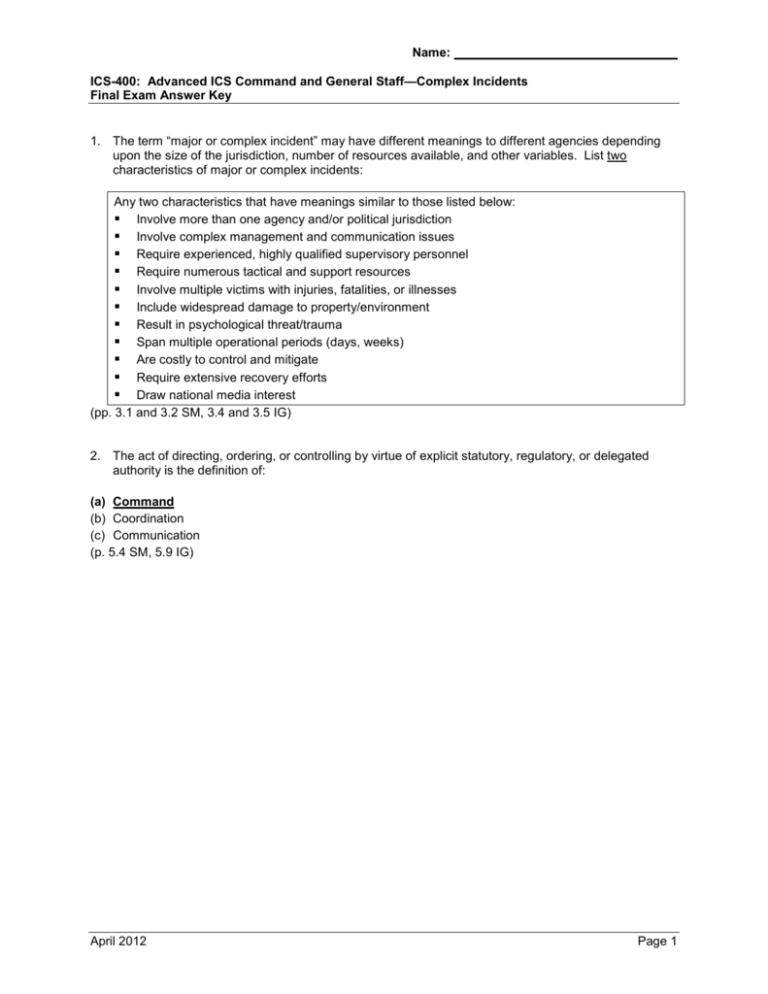Name: ICS-400 - APAN Community SharePoint
advertisement

Name: ICS-400: Advanced ICS Command and General Staff—Complex Incidents Final Exam Answer Key 1. The term “major or complex incident” may have different meanings to different agencies depending upon the size of the jurisdiction, number of resources available, and other variables. List two characteristics of major or complex incidents: Any two characteristics that have meanings similar to those listed below: Involve more than one agency and/or political jurisdiction Involve complex management and communication issues Require experienced, highly qualified supervisory personnel Require numerous tactical and support resources Involve multiple victims with injuries, fatalities, or illnesses Include widespread damage to property/environment Result in psychological threat/trauma Span multiple operational periods (days, weeks) Are costly to control and mitigate Require extensive recovery efforts Draw national media interest (pp. 3.1 and 3.2 SM, 3.4 and 3.5 IG) 2. The act of directing, ordering, or controlling by virtue of explicit statutory, regulatory, or delegated authority is the definition of: (a) Command (b) Coordination (c) Communication (p. 5.4 SM, 5.9 IG) April 2012 Page 1 Name: ICS-400: Advanced ICS Command and General Staff—Complex Incidents Final Exam Answer Key 3. What type of ICS structure is illustrated below? Caption: ICS organization with Incident Command, Operations Section, Planning Section, Logistics Section, and Finance/Admin Sections. Reporting to the Operations Section are Branch I (Incident 1), Branch II (Incident 2), and Branch III (Incident 3). (a) Area Command (b) Incident Complex (c) Unified Command (d) Incident Command Post (p. 3.8 SM, 3.16 IG) 4. State one reason why a single incident may be divided into separate incidents. Any one of the following reasons or another item with meaning similar to those listed below: When an incident spreads into other jurisdiction(s) and Unified Command is not feasible. When it is difficult to manage from one location due to terrain and access. When an incident has objectives that are naturally separating into two operations. When the Planning Section, even with additional resources, can no longer adequately provide planning services. When the Logistics Section can no longer, or will soon not be able to, serve the widespread facilities and operations from a single incident base. When the Operations Section cannot manage the number of resources required without exceeding span of control. (p. 3.10 SM, 3.19 and 3.20 IG) April 2012 Page 2 Name: ICS-400: Advanced ICS Command and General Staff—Complex Incidents Final Exam Answer Key 5. When Branch Tactical Planning is implemented, then: (a) A Tactical Planning Branch with technical specialists is added to the Planning Section in order to provide better support throughout the planning process. (b) The Planning Section becomes a Branch within the Operations Section, thus allowing a more integrated planning process. (c) The Emergency Operations Center establishes a specialized Planning Branch and begins directing planning activities. (d) A Branch within the Operations Section develops detailed action plans while the Planning Section provides support and coordination. (p. 3.13 SM, 3.25 IG) 6. An incident is geographically dispersed, and it is not feasible for the incident base to support the incident logistical needs. Assuming that you do not want to divide the incident in two separate incidents, what is another option for managing this incident? (a) Collocate the logistics base with the staging areas, with the Staging Area Manager assuming responsibility. (b) Divide the Logistics Section into Divisions that represent each geographic area reporting to a Supervisor. (c) Establish a second Logistics Section reporting to a Deputy Incident Commander (Logistics). (d) Have the Emergency Operations Center establish a Logistics Section and assume command responsibility for that function. (p. 3.18 SM, 3.36 IG) 7. Area Command should: (a) Be as large as possible. (b) Function without using Incident Command System principles, to distinguish it from the on-scene incident operations. (c) Receive its authority through informal agreement among the local jurisdictions. (d) Be staffed with qualified and experienced personnel. (p. 4.3 SM, 4.9 IG) 8. A common operating picture (COP): (a) (b) (c) (d) Is not essential, as long as a Multiagency Coordination System has been established. Requires the use of sophisticated photographic equipment. Is only necessary during the initial stages of an incident. Is a single set of critical incident information that is shared by all responders and organizations. (p. 5.14 SM, 5.29 IG) April 2012 Page 3 Name: ICS-400: Advanced ICS Command and General Staff—Complex Incidents Final Exam Answer Key 9. Select the TRUE statement: (a) Area Command replaces the incident-level ICS organizations or functions. (b) Area Command should be collocated with one of the Incident Command Posts. (c) When Area Command is established, the Incident Commander(s) report to the Area Commander. (d) Area Command establishes the Incident Action Plan for the individual Incident Commanders. (p. 4.2 SM, 4.8 IG) 10. Review the following overall responsibilities of the Area Commander. Write in the missing responsibility. Set overall objectives. Ensure objectives are met and do not conflict with each other or agency policy. Establish priorities. Allocate/reallocate critical resources. Ensure that incident management teams are qualified. Coordinate the demobilization of assigned resources. Coordinate with Agency Administrator, EOC, other entities, and the media. (p. 4.16 SM, 4.26 IG) 11. A multiagency coordination system: (a) Integrates facilities, equipment, and personnel that are responsible for coordinating and supporting incident management. (b) Is a standing facility that is responsible for monitoring public safety and threats in order to deploy resources. (c) Requires an assembled group and associated support systems needed to establish policy-level decisionmaking during incidents. (d) Is only activated during incidents that are coordinated at the national level rather than at State and local levels. (p. 5.2 SM, 5.6 IG) April 2012 Page 4 Name: ICS-400: Advanced ICS Command and General Staff—Complex Incidents Final Exam Answer Key 12. Within a Multiagency Coordination System, the policy-level group: (a) Assumes responsibility for incident command and control activities. (b) Is not involved with resource allocation. (c) Will always have the same membership, regardless of the kind of incident. (d) Consists of agency representatives with decisionmaking authority. (p. 5.10 SM, 5.20 IG) 13. List one criterion that a multiagency group may use when establishing priorities. Any one of the following criteria or another item with meaning similar to those listed below: Threat to life Real property threatened High damage potential Incident complexity Environmental impact Economic impact Threat to infrastructure (p. 5.16 SM, 5.34 IG) 14. What facility is established to coordinate all incident-related public information activities, and serves as the central point of contact for all news media at the scene of the incident? (a) Media Information Center (b) Joint Information Center (c) Public Information Center (d) Command Information Center (p. 5.15 SM, 5.31 IG) April 2012 Page 5







